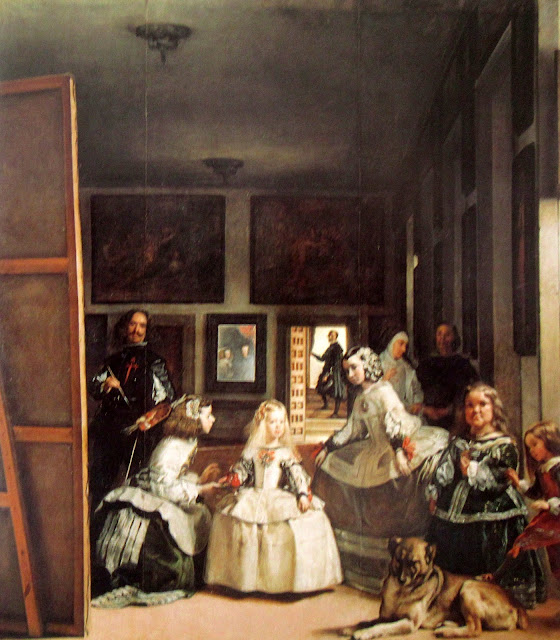Las Meninas (the ladies-in-waiting) by Diego Velazquez has become one of the most widely analysed works in Western painting and is moreover a 'painters' painting'. Its complex and enigmatic composition raises questions about reality and illusion, and it furthermore depicts an uncertain relationship between the viewer and figures depicted.
It depicts a room in the Royal Alazar of Madrid during the reign of Philip IV and presents nine figures, most identifiable from the Spanish court, captured in a particular moment as if in a snapshot. Five of the figures look out of the canvas towards the viewer or is it the royal couple, while four interact among themselves. The five-year-old Infanta Margaret Theresa is surrounded by her entourage of maids of honour, chaperone, bodyguard, two dwarfs and a dog. The large and lunging mastiff endures the taunting toes of a playful young dwarf, beside whom an older female dwarf gazes out at us, reinforcing the feeling that the painting is watching our every move as closely as we are watching it. Just behind them, Velazquez portrays himself working at a large canvas. Velazquez looks outwards beyond the pictorial space to where a viewer of the painting would stand.
In the background there is a mirror that reflects the upper bodies and heads of two figures identified from other paintings as King Philip IV and Queen Mariana. The most common assumption is that the reflection shows the couple in the pose they are holding for Velazquez as he paints them. The king and queen are supposedly 'outside' the painting, yet their reflection in the mirror also places them 'inside' the pictorial space. They appear to be placed outside the picture space in a position similar to that of the viewer, although some scholars have speculated that their image is a reflection from the painting Velzquez is shown working on.
Through an open door in the back of the painting, a hazily articulated figure, the queen's chamberlain, is departing the realm of the painting, but not before pausing to glance back at us, as if anxious that we might be following him to the unknown that lies beyond.
It is these last two aspects of the work - the open doorway through which the chamberlain is endlessly exiting to an elsewhere outside the consciousness of the canvas, and the gauzy shimmer of the royal countenances in the ghostly glass of the mirror - that have provoked observers of the painting to suspect that there is more at play than meets the eye.
The absent presence of the king and queen (who are simultaneously in the painting but not in the scene) forces us to conclude that this is as much a philosophical work about the substance of substance and the hereness of here, as it is a fleeting freeze-frame of lively palace life. The riddle of their reflection ensures we are not passive onlookers but actively seek to understand where in the world they are. Does the mirror position them where we are, on the outside looking, the very subjects of a portrait that Velazquez is at some stage of beginning or finishing? Or is the mirror revealing what is already on that large canvas whose back is turned to us: an imaginary reflection of the surface of an imaginary painting that portrays figures whose imaginary whereabouts we can only imagine?
A dizzying riddle of a painting, Las Meninas plays tug of war with our mind. On the one hand, the canvas' perspective lines converge to a vanishing point within the open doorway, pulling our gaze through the work. On the other hand, the rebounding glare of the mirror bounces our attention back out of the painting to ponder the plausible position of royal spectres whose vague visages haunt the work. We are constantly dragged into and out of the painting as the here-and-now of the shaodwy chamber depicted by Velazques becomes a strangely elastic dimension that is both transient and eternal - a realm at once palpably real and mistily imaginary.
Laura Cumming reflect on Las Meninas' remarkable ability to present 'such a precise vision of reality' while at the same time remaining 'so open a mystery. The knowledge that all this is achieved by brushstrokes, that these are only painted figments, does not weaken the illusion so much as deepen the enchantment. The whole surface of Las Meninas feels alive to our presence'. Cummings' eloquent assessment of the painting's uncanny power, with its carefully chosen language of 'mystery', 'illusion', and 'enchantment', captures perfectly the almost psychotropic effect Velaszuquez' imagery has on us - the trance-like state into which the painting has lured generation after generation. Cuming could almost be describing a hallucination or a mystical vision rather than a painting.
Foucault analysed the conscious artifice of the painting, highlighting the complex network of visual relationships between painter, subject-model and viewer: 'We are looking at a picture in which the painter is in turn looking out at us. A mere confrontation, eyes catching one another's glance, direct looks superimposing themselves upon one another as they cross. And yet this slender line of reciprocal visility embraces a complex network of uncertainties, exchanges and feints. The painter is turning his eyes towards us only in so far as we happen to occupy the same position as his subject'.
For Foucault, Las Meninas illustrates the first signs of a new episteme, or way of thinking. It represents a midpoint between what he sees as the two 'great discontinuities' in European thought, the classical and the modern: 'Perhaps there exists, in this painting by Velazquez, the representation as it were of Classical representation, and the definition of the space it opens up to us... representation, freed finally from the relation that was impeding it, can offer itself as representation in its pure form'.




No comments:
Post a Comment